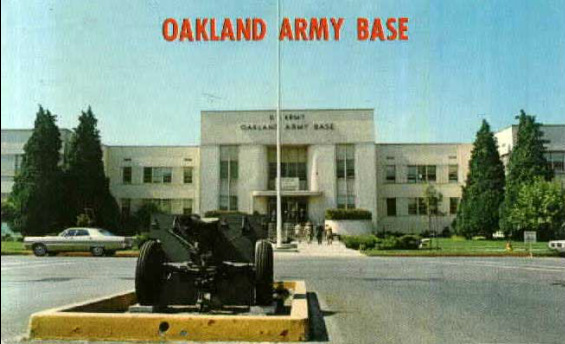Oakland Army Base
The California State Military Museum
Oakland Army Base was constructed and began performing its primary military mission as a transportation port and distribution terminal for the Department of the Army in the early 1940s. Mission support activities included maintaining facilities and equipment, performing industrial processes, repairing and upgrading equipment, preparing vehicles and equipment for overseas shipment, storing fuels and managing wastes, performing cleaning operations, and supporting seagoing vessels, rail, and land transportation fleet service vehicles.
Important events in Oakland Army Base’s development, administration, and mission are summarized below:
1940. The San Francisco Port of Embarkation Board of Officers recommended expanding the Port of Embarkation at Fort Mason, California, and also recommended that waterfront areas in the partially developed Oakland Outer Harbor be acquired to meet expansion needs.
1941. In January, the first land was acquired following War Department approval of the expansion plan. Base operations started on a limited basis in February, using existing site
facilities. Landfill and building construction started in April. “Port and General Depot” was the initial designation of the installation. In December, the “Oakland Sub-Port of the San Francisco Port of Embarkation,” with headquarters at Fort Mason, was officially commissioned.
1942. The Administration Area was officially commissioned and designated as “Camp John T. Knight.”
1943. The Integrated Terminal Facility was completed at a cost of $35 million. All waterfront areas of the base, including the piers, wharves, and warehouses, received the name “Oakland Army Base,” effective January 1944.
1946. The Administration Area was officially combined with the operational areas known as Oakland Army Base. Use of the name Camp John T. Knight was discontinued.
1941-1952. This was one of the busiest periods at Oakland Army Base. The installation moved 8.5 million tons of cargo during the 4 most active years of World War II. During the three active years of the Korean Conflict, 7.2 million tons of cargo passed through the terminal.
1955. Reorganization of the San Francisco Port of Embarkation in October resulted in a name change to U.S. Army Transportation Terminal Command Pacific, and the base became the Oakland Army Terminal.
1965. In February, the Army established five Military Traffic Management and Terminal Services (MTMTS) traffic regions. One of the five, Western Traffic Region, established its
headquarters at the Oakland Army Terminal. In April 1965, the Joint Army-Navy Ocean Terminal, Oakland, California, was transferred from jurisdiction under the Commander General (CG), U.S. Army Material Command (USAMC), to that of the CG, MTMTS. The U.S. Army Terminal Command, Pacific (under the jurisdiction of CG, USAMC) was discontinued and its functions, personnel, equipment, and records were transferred to Commander, Western Area, MTMTS (Western Area, Military Traffic Management and Terminal Services [WAMTMTS]). Western Traffic Region (under the jurisdiction of Commander, MTMTS) was discontinued, and its functions, personnel, equipment, and records were also transferred to Commander, WAMTMTS.
1966-1974. In July 1966, Oakland Army Terminal was renamed Oakland Army Base and reassigned from Commander, MTMTS to HQ WAMTMTS. Oakland Army Base was home to the largest military port complex in the world during the Vietnam era. Operations were handled by the Military Ocean Terminal Bay Area (MOTBA), a subordinate command of Military Traffic Management Command-Western Area (MTMCWA). Over 37 million tons of cargo passed through MOTBA and its associated commercial piers during the 8 years of the Vietnam conflict. During this period, the trend toward containerization changed the marine terminal and ocean shipping industry. A decision was made to not make a military investment in the extensive equipment necessary for container operations. As a result, the traffic manager responsibilities of MTMCWA expanded to include extensive coordination with carriers for the placement and scheduling of container traffic. Over 70 percent of Department of Defense cargo transported during this period through the Bay Area moved under MTMCWA and MOTBA management through commercial container piers in Oakland and San Francisco.
1974. In June, the Department of the Army granted to the Department of the Navy through the Navy Public Works Center, San Francisco, a permit for a 5-year term to use, administer, and maintain the base infrastructure, and to administer, maintain, and occupy the Oakland Army Base family housing (112 units), family housing office and warehouse buildings, and the administrative building. Permit extensions occurred in 1979, 1984, and 1985.
1984. In October 1984, the territorial boundaries of the Military Traffic Management Command (MTMC) Eastern Area and the MTMC Western Area were realigned to give the Eastern Area a 28-state geographic responsibility covering the 1st, 2nd, and 4th Army areas. Western Area was given a 20-state geographic responsibility covering the 5th and 6th Army areas. The realignment also divided the Regional Storage Management Offices and Military Air Traffic coordinating units according to geographic areas of responsibility.
1995. On July 1, the BRAC Commission called for the closure of Oakland Army Base and relocation of the MTMC Western Area and the establishment of an Army Reserve Enclave. The recommendation became effective September 28.
1999. Oakland Army Base officially closed on September 30.
Oakland Army Base was constructed and began performing its primary military mission as a transportation port and distribution terminal for the Department of the Army in the early 1940s. Mission support activities included maintaining facilities and equipment, performing industrial processes, repairing and upgrading equipment, preparing vehicles and equipment for overseas shipment, storing fuels and managing wastes, performing cleaning operations, and supporting seagoing vessels, rail, and land transportation fleet service vehicles.
Important events in Oakland Army Base’s development, administration, and mission are summarized below:
1940. The San Francisco Port of Embarkation Board of Officers recommended expanding the Port of Embarkation at Fort Mason, California, and also recommended that waterfront areas in the partially developed Oakland Outer Harbor be acquired to meet expansion needs.
1941. In January, the first land was acquired following War Department approval of the expansion plan. Base operations started on a limited basis in February, using existing site
facilities. Landfill and building construction started in April. “Port and General Depot” was the initial designation of the installation. In December, the “Oakland Sub-Port of the San Francisco Port of Embarkation,” with headquarters at Fort Mason, was officially commissioned.
1942. The Administration Area was officially commissioned and designated as “Camp John T. Knight.”
1943. The Integrated Terminal Facility was completed at a cost of $35 million. All waterfront areas of the base, including the piers, wharves, and warehouses, received the name “Oakland Army Base,” effective January 1944.
1946. The Administration Area was officially combined with the operational areas known as Oakland Army Base. Use of the name Camp John T. Knight was discontinued.
1941-1952. This was one of the busiest periods at Oakland Army Base. The installation moved 8.5 million tons of cargo during the 4 most active years of World War II. During the three active years of the Korean Conflict, 7.2 million tons of cargo passed through the terminal.
1955. Reorganization of the San Francisco Port of Embarkation in October resulted in a name change to U.S. Army Transportation Terminal Command Pacific, and the base became the Oakland Army Terminal.
1965. In February, the Army established five Military Traffic Management and Terminal Services (MTMTS) traffic regions. One of the five, Western Traffic Region, established its
headquarters at the Oakland Army Terminal. In April 1965, the Joint Army-Navy Ocean Terminal, Oakland, California, was transferred from jurisdiction under the Commander General (CG), U.S. Army Material Command (USAMC), to that of the CG, MTMTS. The U.S. Army Terminal Command, Pacific (under the jurisdiction of CG, USAMC) was discontinued and its functions, personnel, equipment, and records were transferred to Commander, Western Area, MTMTS (Western Area, Military Traffic Management and Terminal Services [WAMTMTS]). Western Traffic Region (under the jurisdiction of Commander, MTMTS) was discontinued, and its functions, personnel, equipment, and records were also transferred to Commander, WAMTMTS.
1966-1974. In July 1966, Oakland Army Terminal was renamed Oakland Army Base and reassigned from Commander, MTMTS to HQ WAMTMTS. Oakland Army Base was home to the largest military port complex in the world during the Vietnam era. Operations were handled by the Military Ocean Terminal Bay Area (MOTBA), a subordinate command of Military Traffic Management Command-Western Area (MTMCWA). Over 37 million tons of cargo passed through MOTBA and its associated commercial piers during the 8 years of the Vietnam conflict. During this period, the trend toward containerization changed the marine terminal and ocean shipping industry. A decision was made to not make a military investment in the extensive equipment necessary for container operations. As a result, the traffic manager responsibilities of MTMCWA expanded to include extensive coordination with carriers for the placement and scheduling of container traffic. Over 70 percent of Department of Defense cargo transported during this period through the Bay Area moved under MTMCWA and MOTBA management through commercial container piers in Oakland and San Francisco.
1974. In June, the Department of the Army granted to the Department of the Navy through the Navy Public Works Center, San Francisco, a permit for a 5-year term to use, administer, and maintain the base infrastructure, and to administer, maintain, and occupy the Oakland Army Base family housing (112 units), family housing office and warehouse buildings, and the administrative building. Permit extensions occurred in 1979, 1984, and 1985.
1984. In October 1984, the territorial boundaries of the Military Traffic Management Command (MTMC) Eastern Area and the MTMC Western Area were realigned to give the Eastern Area a 28-state geographic responsibility covering the 1st, 2nd, and 4th Army areas. Western Area was given a 20-state geographic responsibility covering the 5th and 6th Army areas. The realignment also divided the Regional Storage Management Offices and Military Air Traffic coordinating units according to geographic areas of responsibility.
1995. On July 1, the BRAC Commission called for the closure of Oakland Army Base and relocation of the MTMC Western Area and the establishment of an Army Reserve Enclave. The recommendation became effective September 28.
1999. Oakland Army Base officially closed on September 30.
Gilbreath Hall (Building 1)

Galbrath Hall1964.
Gilbreath Hall (Building 1) at Oakland Army Terminal replaced Fort Mason as headquarters for the U.S. Army Transportation Terminal Command Pacific.
Gilbreath Hall (Building 1) at Oakland Army Terminal replaced Fort Mason as headquarters for the U.S. Army Transportation Terminal Command Pacific.

